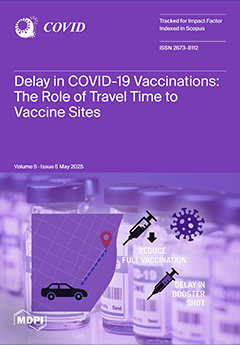In the past 5 years, the COVID-19 pandemic has experienced frequently changing variants contextualizing immune evasion. The emergence of Omicron with >30–50 mutations on the spike gene has shown a sharp divergence from its relative VOCs, such as WT, Alpha, Beta, Gamma, and
[...] Read more.
In the past 5 years, the COVID-19 pandemic has experienced frequently changing variants contextualizing immune evasion. The emergence of Omicron with >30–50 mutations on the spike gene has shown a sharp divergence from its relative VOCs, such as WT, Alpha, Beta, Gamma, and Delta. The requisition of prime boosting was essential within 3–6 months to improve the Nab response that had been not lasted for longer. Omicron subvariant BA.1.1 was less transmissible, but with an extra nine mutations in next variant BA.2 made it more transmissible. This remarkable heterogeneity was reported in ORF1ab or TRS sites, ORF7a, and 10 regions in the genomic sequences of Omicron BA.2 and its evolving subvariants BA.4.6, BF.7, BQ.2, BF. 7, BA.2.75.2, and BA.5 (BQ.1 and BQ.1.1). The mutational stability of subvariants XBB, XBB 1, XBB 1.5, and XBB 1.6 conferred a similar affinity towards ACE-2. This phenomenon has been reported in breakthrough infections and after booster vaccinations producing hybrid immunity. The reduced pathogenic nature of Omicron has implicated its adaptation either through immunocompromised individuals or other animal hosts. The binding capacity of RBD and ACE-2, including the proteolytic priming via TMPRSS2, reveals its (in-vitro) transmissibility behavior. RBD mutations signify transmissibility, S1/S2 enhances virulence, while S2 infers the effective immunogenic response. Initial mutations D614G, E484A, N501Y, Q493K, K417N, S477N, Y505H, and G496S were found to increase the Ab escape. Some mutations such as, R346K, L452R, and F486Vwere seen delivering immune pressure. HR2 region (S2) displayed mutations R436S, K444T, F486S, and D1199N with altered spike positions. Later on, the booster dose or breakthrough infections contributed to elevating the immune profile. Several other mutations in BA.1.1-N460K, R346T, K444T, and BA.2.75.2-F486S have also conferred the neutralization resistance. The least studied T-cell response in SARS-CoV-2 affects HLA- TCR interactions, thus, it plays a role in limiting the virus clearance. Antigenic cartographic analysis has also shown Omicron’s drift from its predecessor variants. The rapidly evolving SARS-CoV-2 variants and subvariants have driven the population-based immunity escape in fully immunized individuals within short period. This could be an indication that Omicron is heading towards endemicity and may evolve in future with subvariants could lead to outbreaks, which requires regular surveillance.
Full article





